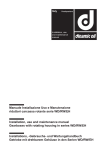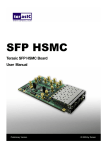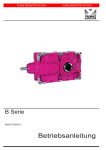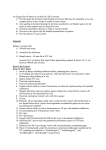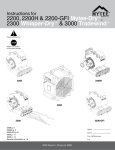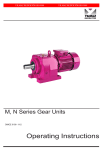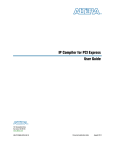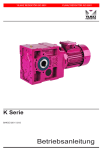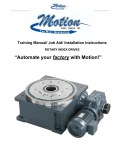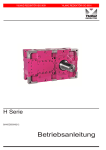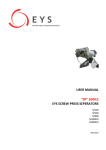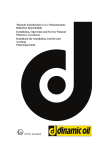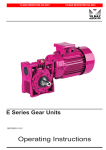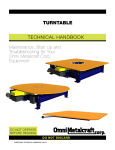Download READ - Comer Industries
Transcript
Certified Quality System UNI EN ISO 9001 : 2008 www.comerindustries.com 312 SERVICE MANUAL PGRF series Release A10/14 First issue 10/14 Release A10/14 INDEX GENERAL INFORMATION........................................................................................................................................................................................ 3 GEARBOX UNIT IDENTIFICATION.............................................................................................................................................................. 3 RISKS AND PRECAUTIONS......................................................................................................................................................................... 3 TRANSFER AND STORAGE........................................................................................................................................................................ 3 HANDLING.................................................................................................................................................................................................... 3 PRODUCT DISPOSAL.................................................................................................................................................................................. 3 GEARBOX UNIT............................................................................................................................................................................................ 4 INTENDED USE AND LIMITATIONS............................................................................................................................................................ 4 LUBRICANT.................................................................................................................................................................................................. 4 ORDINARY MAINTENANCE..................................................................................................................................................................................... 5 MAINTENANCE............................................................................................................................................................................................. 5 MAINTENANCE INTERVALS........................................................................................................................................................................ 5 OIL REPLACEMENT PROCEDURE......................................................................................................................................................................... 6 OIL DRAINING.............................................................................................................................................................................................. 6 OIL TOPPING OFF........................................................................................................................................................................................ 6 OIL FILLING.................................................................................................................................................................................................. 6 INSTALLATION AND START UP................................................................................................................................................................... 7 PRELIMINARY CHECKS AND INSTALLATION............................................................................................................................................ 7 START UP..................................................................................................................................................................................................... 7 MALFUNCTIONING AND FAILURE.............................................................................................................................................................. 7 FUNCTIONING INTERRUPTION............................................................................................................................................................................... 7 TROUBLESHOOTING............................................................................................................................................................................................... 8 TORQUE WRENCH SETTING.................................................................................................................................................................................. 9 This manual : • provides all information about ordinary maintenance, installation and use for this unit, • must be read and understood by the authorized people/operators before any kind of intervention, • must be kept handy, in a safe place and must always be clear and legible for future reference whenever needed. SYMBOLS USED OBLIGATION Operation to be observed PROTECTIVE CLOTHING Protective clothing must always be worn by personnel authorized to work with reduction gears. PROHIBITION Do not work with machines in movement SAFETY GLASSES Safety glasses must be worn by all autorized people to work on the reduction gear WARNING Operation must be carried out with extreme care with personal injury if proper procedures are not followed SAFETY GLOVE Safety glove must be worn by all autorized people to work on the reduction gear DANGER Be careful of hanging loads SAFETY SHOES Safety shoes must be worn by all autorized people to work on the reduction gear PGRF 2/9 First issue 10/14 Release A10/14 GENERAL INFORMATION GEARBOX UNIT IDENTIFICATION RISKS AND PRECAUTIONS All the data which characterize the gear unit are reported on the name plate attacched on the unit. Safety of authorized workers must be guarantee. Provide all authorized worker with all necessary and specific IPG. Example: Slip-proof shoes should be worn, because there is oil in the reduction gear and during maintenance some of it may leak in the working area. Always handle the units with adequate lifting means. ADDITIONAL PRECAUTIONS • Guarantee an effective prevention system by constantly monitoring cleaning and integrity of the structures. • Actuate a specific periodical cleaning and maintenance plan of the unit. • In case of accidental overloads or damage to the unit, stop functioning unit and carry out a repairing procedure. Do not work with machines in movement. TRANSFER AND STORAGE The unit is best stored in closed and covered environments. Do not store the unit ouside or directly onto the ground. If the unit is stored for long periods (over 3 month), these must be externally protected with anti-oxidizing products and filled with oil to protect the internal components. Care should also be used to avoid violent impact. HANDLING Handling, lifting and transportation must be carried out by qualified, authorized and appropriately trained personnel. Before and during unit handling: • check the stability of the unit; • verify that the lifting means and its accessories (ropes, hooks, etc.) are suitable to lift and handle the unit; • follow strictly the regulations in force for security and prevention of industrial injuries. Manual loads: If the unit or its parts must be handled manually, limit the load to 10Kg. We recommend lifting the load by keeping it as close as possible to the body and bending the knees and not the back. PRODUCT DISPOSAL Environmental protection: Local rules must be complied with in regard to the laws existing in the country where the machine is used PGRF The disposal of waste material deriving from machine/components demolition must be done with respect for the environment, without polluting land, air or water. Dismantling: parts and components must be disassembled and separated in according to the materials they are made of: iron, aluminium, copper, plastic, rubber, etc. Components and parts must be disposed of by the relative centres in full compliance with the laws in force on the matter of dismantling and demolishing industrial waste. Packages (pallets, carton boxes, paper, plastic, etc.) to lead into regeneration/recycling circuits as far as possible, by delivering separate waste classes to authorized compaines. Waste oil/grease: to dispose of waste oil abide by the laws for protecting the environment and the laws in force in the Country where the machine is used. 3/9 First issue 10/14 Release A10/14 GENERAL INFORMATION GEARBOX UNIT Most materials of these gearboxes are made of high quality steel and cast iron that have to comply with the increasingly strict requirements on workability, resistance to distortion, to fatigue failures and to wear, safety and durability. All technical information are described in the documents referred to the specific unit code. Brake unit: the unit could be equipped with hydraulics negative brakes with oil-bath disks, expressly designed for static or parking braking. Correct braking values are described on the specific external drawing. WARNING: It is strictly forbidden to use it as a dynamic brake. Hydraulic motor: to select the hydraulic motor take into consideration the maximum performance of the reduction gear. INTENDED USE AND LIMITATIONS This gearbox unit must be: • used only for industrial application; • used with correct type and quantities of lubricants; • handled, assembled, installed, used and maintained in compliance with this manual; • handled, assembled, installed, used and maintained only by authorized workers/operator. It is forbidden: • to use the gearbox unit in a way that does not conform to the technical specifications and the intended use described in this manual; • to install and use this gearbox unit in environments with explosion risks; • to use the gearbox unit with safety devices removed or disabled. External drawing and documents annexed to the unit, report: • technical informations; • dimensions and characteristics; • maximum number of input/output speed (rpm); • maximum functioning values (torque, dimensions, etc...). LUBRICANT Gearboxes normally are supplied without lubricant. Type and quantity of lubricant are indicated on the specific external drawing. All fluids used must be compatible with all the components, elastomers and seals. Oil type Example Viscosity Oil Type Oil name Example Mineral ISO VG 150 - 10°C + 30°C ISO VG 220 + 10°C + 45°C ISO VG 320 + 30°C + 60°C Synthetic PAO - 20°C + 60°C PG - 20°C + 60°C La viscosità aumenta al diminuire della temperatura e viceversa Producer SHELL EXXON MOBIL KLÜBER AGIP BP CASTROL CHEVRON TOTAL PGRF Ambient temperature t°C (min / max) Lubricants Mineral Omala S2G Mobilgear XMP Kluberoil GEM1 Blasia Energol GR‐XP Alpha SP Ultra Gear Carter EP Synthetic PAO PG Omala S4GX Omala S4 WE Mobil SHC Gear Glygoyle Klubersynth EG4 Klubersynth GH6 Blasia SX Blasia S Enersyn EPX Enersyn SG XP Aphasyn EP Alphasyn PG Tegra Synthetic Gear HiPerSYN Carter SH Carter SY Lubrificante per uso alimentare: contattare il servizio tecnico commerciale Lubrificante biologico: contattare il servizio tecnico commerciale 4/9 First issue 10/14 Release A10/14 ORDINARY MAINTENANCE Maintenance operations must be carried out by qualified, trained and authorised personnel MAINTENANCE To guarantee long life and excellent performance to the gear unit, maintenance operations must be done on a regular basis. Before maintenance operations, authorized people must disconnect the unit power supply, putting it “out of order”, taking all the necessary precautions to ensure it cannot be restarted accidentally or any of its moving parts. When maintenance operations are finished, restore all safety conditions of functioning During maintenance operations: • it is forbidden to work with machines in movement, • wear suitable protection (IPG), • avoid accidental restart of the unit , • oil leaks should not be a source of danger, • do not handle units that are still very hot. ORDINARY MAINTENANCE includes: • check of oil level and oil leaks, • oil topping off, • oil replacement, • grease topping off, • periodical inspection. Note: Instruction for extraordinary maintenance are NOT described in this manual EXTRAORDINARY MAINTENANCE include: • disassembly and reassembly; • replacement of wearing or damaged parts; • bearing replacement; • oil seals replacement. MALFUNCTION AND ANOMALIES When malfunctions/anomalies are found: • schedule an immediate/anticipated general overhaul; • replace damaged or faulty components with new components if necessary. MAINTENANCE INTERVALS Note: described maintenance intervals could be different with different machine duty cycle PGRF Inspection and Operations Intervals Oil leakage before functioning Brake functioning before functioning Oil and surface temperature on functioning Noise and vibrations on functioning FIRST OIL CHANGE only after initial 100 service hours Oil level check every 500 service hours or monthly Unit and plugs cleaning, oxidation, damage every 500 service hours ORDINARY MAINTENANCE every 2000 service hours or at least once a year Oil replacement ordinary maintenance Presence of water in the oil after oil draining Brake test ordinary maintenance Screws/plugs tightening torque ordinary maintenance EXTRAORDINARY MAINTENANCE every 5000 service hours Oil seals replacement extraordinary maintenance Bearings replacement extraordinary maintenance Brake disks and springs replacement extraordinary maintenance 5/9 First issue 10/14 Release A10/14 OIL REPLACEMENT PROCEDURE Maintenance operations must be carried out by qualified, trained and authorised personnel OIL DRAINING Warning - BURNS The oil could be very hot and could cause burns PROCEDURE: • Position the unit with drain plug ( ) placed down. • Drain the oil: unscrew the drain plug ( ) and, to ensure that all the oil has been removed, also unscrew the level plugs. After oil draining: • replace all plugs and relatives washers or o-ring, • refit all plugs and relatives washer on place in their seats. In order to avoid sludge deposits, change the oil while the gear unit is still warm. EXAMPLE OF PLUGS LAY OUT FILLING PLUG OIL LEVEL Note: correct plugs configurations are illustrated on the specific external drawings OIL LEVEL PLUG PLUG DRAIN PLUG GROUND OIL TOPPING OFF PROCEDURE: OIL FILLING PROCEDURE: • • • • • • DRAIN PLUG GROUND Remove filling ( ) and level plug ( ). Topping up the unit adding oil lubricant from the upper hole (filling plug hole) until correct OIL LEVEL reached: the oil flow out from the OIL LEVEL hole. Remove filling ( ) and level plug ( ). Fill the unit adding oil lubricant from the upper hole (filling plug hole) until correct OIL LEVEL reached: the oil flow out from the OIL LEVEL plug hole. When the oil filling procedure is finished, replace and tightening all plugs. Correct oil quantity is indicated on the specific external drawing. EXAMPLE OF PLUGS LAY OUT FILLING PLUG FILLING PLUG OIL LEVEL Note: correct plugs configurations are illustrated on the specific external drawings PLUG GROUND Turn 90° counter-clockwise Note: for an effective oil change, the unit should be flushed through with a liquid detergent recommended by the lubricant supplier PGRF OIL LEVEL PLUG DRAIN PLUG GROUND Warning: if the quantity of oil used during topping off is greater than 10 % of the oil capacity then check again for leaks Warning: Do not mix synthetic lubricants with mineral lubricants 6/9 First issue 10/14 Release A10/14 INSTALLATION and START UP Installation and start-up must be carried out by qualified, trained and authorised personnel PRELIMINARY CHECKS AND INSTALLATION Before installation check and verify: • motor type and connection; • that unit components are not damaged and that the centering parts are not rusty; • unit installation diagram; • oil level/lubricant and type of lubricant; • correct plug installation and efficiency; • that the reduction gear screws and plugs have been tightened with correct values ; • that there are no hazardous atmosphere in the work area. To guarantee the correct unit installation: • remove dirt and grease from the unit; • lubricate spigots and coupling surfaces; • centering and fixing the unit without forcing; • dents or sparks must not be created/produced; • friction between moving parts must be absent; • install and fix the unit and all components correctly; • take care not to deform the contact surfaces. START UP Before start up: • remove unnecessary keys and tools; • restore all unit safety system; • all preliminary checks have been done; • verify plugs and screws tightening; • there are no oil leaks; • make sure no radial or axial forces are applied; • verify correct unit alignment with the structure; • verify motor power connection; • there are no obstacles that can influence the correct operation of the units; Start-up and running in: increase gradually torque and rotation values until max values allowed are achieved. After starting up : • friction between moving parts must be absent; • excessive noise and vibration must be absent; • carry out functional tests to verify: • correct functioning of the unit; • correct functioning of the safety system of the unit; • that values functioning are respected. Brake test: carry out engage/disengage test to verify correct unlock pressure value and the brake torque value (correct values are described on the specific external drawings). In case of malfunctioning: 1. interrupt and disable the functioning of the machine, 2. check and verify correct installation, 3. schedule an immediate/anticipated general overhaul of the gearbox unit. MALFUNCTIONING In case of malfunctioning or failure: 1.disconnect the unit malfunctioning, AND FAILURE 2.carry out a maintenance or repair plan, 3.replace the damaged or faulty components with new components. FUNCTIONING INTERRUPTION PGRF Disconnect unit malfuntioning and avoid accidental run of the unit. Interrupt and disable the functioning of the machine/vehicle during maintenance operations, general overhaul or revision procedures (e.g. lifting the wheels off the ground, turning off the work procedure...etc...) to avoid hurting operators and other people. 7/9 First issue 10/14 Release A10/14 TROUBLESHOOTING Problems 1) Damaged or worn seals; 2) Breather plug clogged; 1) Contact Comer Industries; 2) Clean or substitute the plug Excessive overheating 1) There is no oil in the unit; 2) Incorrect level of lubricant; 3) Brake malfunctioning; 4) Excessive layer of dust; 5) Inadeqaute ventilation; 6) Internal problem. 1) Filling the unit with oil; 2) Restore correct level of lubricant (oil/grease); 3) Verify brake functioning; 4) Clean the unit; 5-6) Contact Comer Industries; Excessive noise 1 Internal problem •Restore correct oil level. •Restore correct grase q.ty. •Contact Comer Industries. Excessive noise 2 External problem •Verify screws/connection. •Verify unit installation. 1) Incorrect installation; 2) Internal problem; 1) Verify installation and screws tightening; 2) Contact Comer Industries; The unit fail to run 1) Incorrect motor installation; 2) Internal problem 1) Verify motor installation and connection; 2) Contact Comer Industries; Wrong rotation unit direction Uncorrect motor connection Verify unit installation and connection; The unit does not rotate 1) Incorrect motor installation; 2) Internal problem 1) Verify motor installation and connection; 2) Contact Comer Industries; 1) Brake components damaged or worn; 1) Replace brake components; 1) Incorrect dimensioning •Verify unit scheme. •Contact Comer Industries. Brake malfunctioning PGRF Remedies Oil leaks Excessive vibration In case of different problems from this table, contact the Technical-Commercial Service Comer Industries Possible cause The unit cannot assembled on the structure machine Maintenance data sheet Maintenance data sheet Date of maintenance work ................................ Date of maintenance work ................................ Operating hours ................................................ Operating hours ................................................ Comer Industries code ..................................... Comer Industries code ..................................... Serial number .................................................... Serial number .................................................... Work carried out: Work carried out: 8/9 First issue 10/14 Release A10/14 TORQUE WRENCH SETTING (N x m) Screw on steel or cast iron PGRF 9/9









